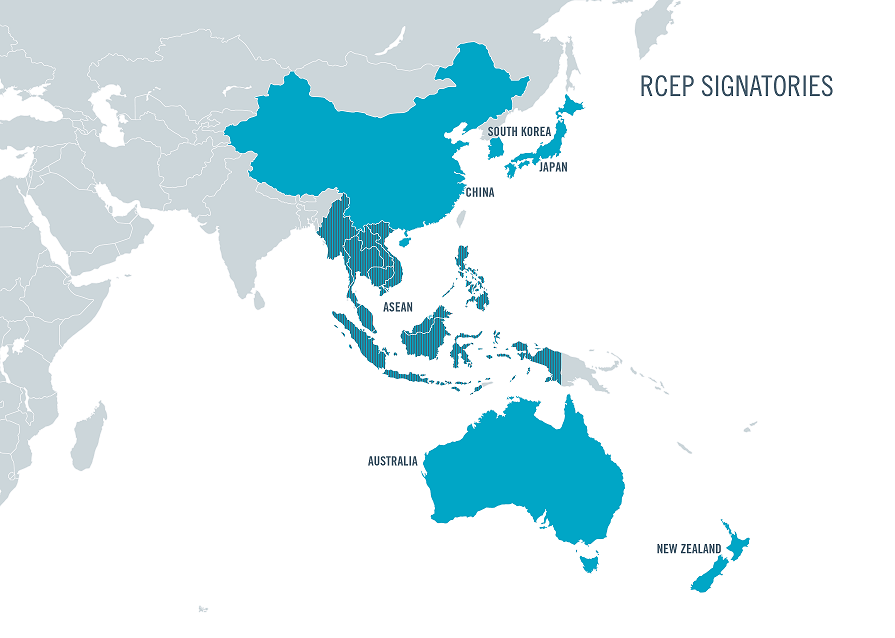Asia-Pacific Signals Strong Commitment to Economic Integration and Cooperation with RCEP Signing
This publication is issued by K&L Gates in conjunction with K&L Gates Straits Law LLC, a Singapore law firm with full Singapore law and representation capacity, and to whom any Singapore law queries should be addressed. K&L Gates Straits Law is the Singapore office of K&L Gates, a fully integrated global law firm with lawyers located on five continents.
After eight years of negotiations, the Regional Comprehensive Economic Partnership (RCEP)—covering 15 economies in the Asia-Pacific region, accounting for 30 percent of the global population, 30 percent of global GDP, and 34 percent of global investment flows—was finally signed on November 15, 2020. The RCEP is expected to enter into force in 2021.

Besides being the world’s largest free trade agreement (FTA)1, one of the most significant achievements is that the RCEP will finally realize the economic integration of the three Northeast Asian geopolitical rivals: China, Japan, and South Korea. ASEAN2 (comprising Brunei Darussalam, Cambodia, Indonesia, Lao PDR, Malaysia, Myanmar, Philippines, Singapore, Thailand, and Vietnam) already has FTAs (commonly known as ASEAN+ FTAs) with the other five parties to the RCEP (i.e., Australia, New Zealand, China, Japan and Republic of Korea).
The RCEP is an excellent showcase of the art of compromise in international trade negotiations. It not only brings together vastly disparate economies with huge differences in standards of living and economic conditions, but seeks to ensure that the RCEP signatories can and will effectively implement the agreement.
| RCEP Signatory | Total Population (2019, million) |
GDP (2019, US$ billion) |
GDP per capita (2019, US$) |
|---|---|---|---|
| Brunei Darussalam | 0.43 | 13.47 | 31,087 |
| Cambodia | 16.49 | 27.09 | 1,643 |
| Indonesia | 270.63 | 1,119.19 | 4,136 |
| Lao PDR | 7.17 | 18.17 | 2,535 |
| Malaysia | 31.95 | 364.70 | 11,415 |
| Myanmar | 54.05 | 76.09 | 1,408 |
| Philippines | 108.12 | 376.80 | 3,485 |
| Singapore | 5.70 | 372.06 | 65,233 |
| Thailand | 69.63 | 543.65 | 7,808 |
| Vietnam | 96.46 | 261.92 | 2,715 |
| ASEAN | 660.62 | 3,173.14 | 4,803 |
| Australia | 25.36 | 1,392.68 | 54,907 |
| New Zealand | 4.92 | 206.93 | 42,084 |
| China | 1,397.72 | 14,342.90 | 10,262 |
| Japan | 126.26 | 5,081.77 | 40,247 |
| Korea, Rep. | 51.71 | 1,642.38 | 31,762 |
| RCEP | 2,266.59 | 25,839.81 | 11,400 |
| World | 7,673.53 | 87,697.52 | 11,429 |
(Data Source: The World Bank)
The RCEP is keeping its doors open to other economies, allowing “any State or separate customs territory” to accede 18 months after the date of entry into force of the agreement, subject to the consent of the current parties. India will be considered an original negotiating State and can accede to the RCEP at any time. As WTO Members and separate custom territories, Hong Kong and Macau may participate in the RCEP, and perhaps, even the separate customs territories of Taiwan, Penghu, Kinmen and Matsu (Chinese Taipei).
While some commentators consider the RCEP a China-led initiative, seasoned analysts in the region see hallmarks of ASEAN’s centrality in the agreement. ASEAN-centered trade agreements tend to be more accommodative of local sensitivities while at the same time, provide for improvements over time. As such, there is optimism that the RCEP in its current form will be a cornerstone for further economic integration in the Asia-Pacific region.
In the forthcoming series of publications on the RCEP, K&L Gates will focus on three key areas which businesses operating in the region should consider.
Value Chains and Trade Facilitation
Market access for goods is not very significant under the RCEP as tariffs on most items are already eliminated under other FTAs. However, businesses may leverage the RCEP to consolidate their value chains vertically within the bloc. Imagine—minerals from Australia will be shipped to China, Korea or Japan for processing; then transferred to Thailand for further processing into intermediate products; and finally to Vietnam for assembly and finishing. The final product will then be sold into China. At every stage of the value chain, goods transferred between the RCEP parties will not be subject to import duties.
What is even more interesting are the trade facilitation provisions under the RCEP, which will reduce costs and time for moving goods across the region. The RCEP institutionalizes an expedited customs procedures and formalities mechanism for “authorized operators”, which will include elements such as low documentary and data requirements; low rate of physical inspections and examinations; rapid release time; deferred payment of duties, taxes, fees, and charges; use of comprehensive guarantees or reduced guarantees; a single customs declaration for all imports or exports in a given period; and clearance of goods at the premises of the authorized operator or another place authorized by a customs authority. The RCEP also establishes the timeframe for goods clearance, including for perishables. K&L Gates will examine in greater detail the trade facilitation measures which will be put in place under the RCEP.
Dispute Resolution
While the RCEP may hold significant promise for certain gains in trade, foreign investors would be wise to conduct reasonable due diligence before finalizing investment plans on the basis of potential opportunities arising from the RCEP.
The RCEP does contain a number of treaty obligations with regard to the promotion and protection of foreign investments, but there are also some variations from the familiar terms of substantive protections that are used in many other international investment agreements. These terms as employed in the RCEP may not provide the same degree of protection that may be available under other international investment agreements, including applicable bilateral investment treaties.
In fact, in certain circumstances, the RCEP even provides for the denial of investment protection benefits that otherwise would be applicable, such as in the case of an investor incorporated in one RCEP Party for the sole purpose of investment in another RCEP Party where the investing entity is owned or controlled by legal persons of a third non-RCEP Party. In this regard, foreign investors will also need to consider whether their present or future ownership or control may affect any benefits they may otherwise have received under the RCEP.
Most importantly, however, it remains to be seen whether and how the RCEP may provide a mechanism for dispute resolution at all between investors and RCEP Parties. For now, the RCEP merely provides for negotiations in this regard to start within two years after entry into force of the agreement. Until such a mechanism for investor-State dispute settlement is put into place, investors will be unable to initiate proceedings independently as the need may arise from the breach of substantive obligations for the promotion and protection of covered investments under the RCEP.
Ultimately, while the RCEP may open interesting doors of opportunity for trade, foreign investors would be wise to consider the broader context of investment promotion and protection in specific jurisdictions (including any investment protections that may exist under other applicable international investment agreements) prior to entering into investments in RCEP Parties. K&L Gates will further explore the implications of RCEP for foreign investors in a forthcoming publication.
Electronic Commerce
The Electronic Commerce chapter of the RCEP addresses many causes of friction in cross-border e-Commerce transactions including inconsistent or opaque rules regarding the use and acceptance of electronic signatures, varying consumer protection regulations, fraud and misleading practices, and unsolicited electronic email and text messages. However, there are few specific prescriptive provisions, and instead the focus in many areas is on better disclosure of rules and practices and more cooperation and dialog among the RCEP Parties.
There are some key provisions with which the Parties must comply. For example, a Party may not require a business to use or locate computing facilities in that Party’s territory in order to operate in the territory, and Parties must adopt measures to give recipients the ability to stop receiving unsolicited electronic messages.
Even though most e-Commerce regulation is left up to the Parties, there are important steps each Party must take in creating more transparency and cooperation in cross-border e-Commerce transactions. These measures should alleviate some uncertainty and regulatory concerns in these transactions and improve the economic environment for all Parties and e-Commerce participants.
The RCEP presents a means and opportunity for the Parties and e-Commerce businesses to make significant progress toward the goal of seamless cross-border transactions. The true benefits of this RCEP chapter can be most fully realized if e-Commerce businesses from all member Parties work together to help the Parties clearly identify the practical and regulatory hurdles they face and specific ways to minimize them.
This publication/newsletter is for informational purposes and does not contain or convey legal advice. The information herein should not be used or relied upon in regard to any particular facts or circumstances without first consulting a lawyer. Any views expressed herein are those of the author(s) and not necessarily those of the law firm's clients.







